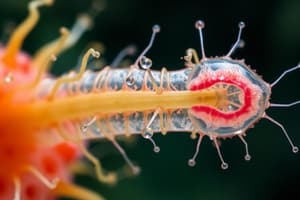Podcast
Questions and Answers
What are the three domains in the Linnaean system of classification?
What are the three domains in the Linnaean system of classification?
- Mammals, Birds, Reptiles
- Animals, Plants, Fungi
- Prokaryotes, Eukaryotes, Viruses
- Bacteria, Archaea, Eukarya (correct)
Which of the following comes after a genus in the classification of organisms?
Which of the following comes after a genus in the classification of organisms?
- Class
- Order
- Species (correct)
- Family
What is the name given to the subdivision of a species that can be interbred within their own group but not with others?
What is the name given to the subdivision of a species that can be interbred within their own group but not with others?
- Subspecies (correct)
- Variety
- Kingdom
- Genus
Which characteristics are used to classify organisms like lions based on size, shape, and color?
Which characteristics are used to classify organisms like lions based on size, shape, and color?
What provides more accurate and detailed information about the relationships between different species in classification?
What provides more accurate and detailed information about the relationships between different species in classification?
Which part of an organism's classification includes phyla, orders, families, genera, and species?
Which part of an organism's classification includes phyla, orders, families, genera, and species?
What is the main difference between prokaryotic and eukaryotic cells?
What is the main difference between prokaryotic and eukaryotic cells?
Which type of living organism lacks a nucleus and other membrane-bound organelles?
Which type of living organism lacks a nucleus and other membrane-bound organelles?
What characteristic is essential for an organism to be classified as living?
What characteristic is essential for an organism to be classified as living?
Which system of classification is commonly used for living organisms?
Which system of classification is commonly used for living organisms?
Which type of cells enclose most of their genetic material within a nucleus?
Which type of cells enclose most of their genetic material within a nucleus?
What is the fundamental unit of life?
What is the fundamental unit of life?
Flashcards are hidden until you start studying
Study Notes
Cell Biology
Cells are the basic units of life. They reproduce, grow, respond to their environment, and carry out essential functions to maintain an organism's health. There are two main types of cells: prokaryotic and eukaryotic.
Prokaryotes
Prokaryotic cells lack a nucleus and other membrane-bound organelles. These organisms can live independently or together with other organisms in symbiotic relationships. Examples of prokaryotes include bacteria and archaea.
Eukaryotes
Eukaryotes have membrane-bound organelles, including a nucleus that encloses most of the cell's genetic material. Plant and animal cells are examples of eukaryotic cells. A typical eukaryote might measure from 0.001 millimeters across in the case of some fungi spores to around 1 meter in height for a large plant like a tree.
Living Organisms
Living organisms are those which exhibit certain characteristics such as movement, growth, reaction to stimuli, reproduction, and metabolism. All living organisms are composed of one or more cells. The cell is the fundamental unit of life.
Organisms and Their Classification
The classification of living organisms is a fundamental aspect of biology. The classification system used today is the Linnaean system, devised by the Swede Carl Linnaeus in the 18th century. The system breaks down all living organisms into groups based on their physical characteristics.
Domains
The Linnaean system divides all living organisms into three domains: Bacteria, Archaea, and Eukarya. The classification goes from the most general to the most specific.
Species
Within each domain are various kingdoms. The classification within each kingdom is further broken down into phyla, orders, families, genera, and species. Each species is unique and cannot be interbred with any other species to produce offspring.
Genus and Species
The name of a species is given by its genus and species names. For example, humans are classified as belonging to the genus Homo and species sapiens.
Subspecies
Some species have subspecies, which are subdivisions of a species that can be interbred within their own subspecies but not with other subspecies.
Classification of Organisms
Classification is a vital part of understanding biological relationships and evolution. The classification of organisms includes both their physical characteristics and their genetic makeup.
Physical Characteristics
Physical characteristics such as size, shape, and color are used to classify organisms. For example, the classification of a large, four-legged animal like a lion would include its size, color, and number of limbs.
Genetic Characteristics
Genetic characteristics, such as the structure and sequence of DNA, are also used in classification. These characteristics are more complex to study and understand but provide more accurate and detailed information about the relationships between different species.
Conclusion
Understanding the basics of biology, including cells, living organisms, and classification, is essential for appreciating the complexity and diversity of life on Earth. From the smallest prokaryotic cells to the largest eukaryotic organisms, all life shares common traits and can be understood through the principles of cell biology and classification.
Studying That Suits You
Use AI to generate personalized quizzes and flashcards to suit your learning preferences.




